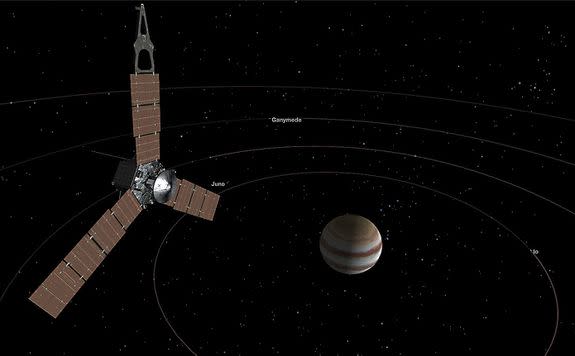Fly above Jupiter's terrifying north pole in new NASA video

Jupiter's north pole is unsettling, at best. It's comprised of one giant storm encircled by eight spinning cyclones — all of which have larger diameters than the moon.
Fortunately, this nightmarish place orbits as far as 600 million miles away from Earth. But for those willing, NASA scientists have made a 3D tour through the tempestuous clouds.
SEE ALSO: NASA's TESS is going to be your new favorite space mission
Unveiled Wednesday at the European Geosciences Union General Assembly in Vienna, Austria, the 1 minute and 20-second plunge through what appears to be hell's inferno is composed of images taken by a camera aboard the Juno spacecraft, which is currently orbiting the planet.
Describing Jupiter's north pole (or atmosphere generally) as hell, however, is misleading, as it's quite cold. The bright yellow clouds are around 9 degrees Fahrenheit, while the dark red clouds plummet down to minus-181 degrees Fahrenheit, according to NASA.
Juno caught these images of Jupiter's north pole during its during its fourth close pass by the planet. The camera used, JIRAM, is an infrared camera, so it can capture clouds 45 miles down from the cloud tops during either day or night (infrared is a non-visible form of light).
Prior to Juno's arrival at Jupiter in 2016, Jupiter largely remained a mystery.

Image: Nasa
"Before Juno, we could only guess what Jupiter’s poles would look like,” Alberto Adriani, Juno co-investigator from the Institute for Space Astrophysics and Planetology in Rome, said in a statement.
“Now, with Juno flying over the poles at a close distance it permits the collection of infrared imagery on Jupiter’s polar weather patterns and its massive cyclones in unprecedented spatial resolution.”
So far, Juno has mapped about a third of the planet, having travelled some 122 million miles during 11 close passes by Jupiter's roiling clouds.
Juno will dive in for its twelfth (terrifying) pass on May 24.
WATCH: Scientists found a weird galaxy without dark matter


